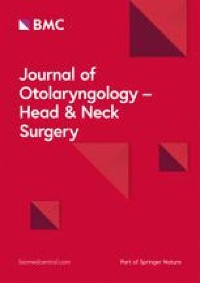|
Αρχειοθήκη ιστολογίου
-
►
2023
(256)
- ► Φεβρουαρίου (140)
- ► Ιανουαρίου (116)
-
►
2022
(1695)
- ► Δεκεμβρίου (78)
- ► Σεπτεμβρίου (142)
- ► Φεβρουαρίου (155)
-
▼
2021
(5507)
- ► Δεκεμβρίου (139)
- ► Σεπτεμβρίου (333)
-
▼
Ιουνίου
(567)
-
▼
Ιουν 27
(34)
- Regional disease in head and neck cutaneous squamo...
- Epley’s Manoeuvre: A Single Line Treatment for Pos...
- Prolonged ulcerative laryngitis
- Definition and illustration of the different types...
- Critical aspects of the transmandibular approach t...
- Continuing education and training-where does it be...
- Prognostic factors for overall survival in orophar...
- 'Ear rage': misophonia : Review and current state ...
- Renal Pelvis Opacification on Postmyelography Comp...
- Images: Unilateral rhinorrhea in a patient startin...
- Proceedings of the Canadian Thyroid Cancer Active ...
- Fixed vs Measured Length of Stapes Prosthesis in S...
- Survival and toxicity in patients with human papil...
- Surgical Outcome of Potassium-Titanyl-Phosphate (K...
- The Acid Test: Proton Pump Inhibitors in Persisten...
- Characterization of otologic involvement in patien...
- The diagnostic utility of clinical exome sequencin...
- The Role of the Skin Microbiota in the Modulation ...
- Can plantar fibroblast implantation protect ampute...
- Severe acute orthostatic headache: spontaneous int...
- Perceptual awareness negativity: a physiological c...
- Comparative Analysis of Cortical Auditory Evoked P...
- Multicentric Intra/Extracranial Cystic Facial Nerv...
- FACE-Q craniofacial module: Part 2 Psychometric pr...
- Lymphography change after liposuction: Possible ne...
- New European Medicines Agency approval: Tucatinib ...
- SEC61G identified as a prognostic biomarker of hea...
- Audiological results and subjective benefit of an ...
- The Effects of Neurodevelopmental Therapy on Feedi...
- Supracricoid Partial Laryngectomy With and Without...
- The impact of COVID‐19 on elective otolaryngology ...
- The role of sepsis screening, SIRS and qSOFA in He...
- Increased incidence of unilateral sudden sensorine...
- Prognosis and Outcomes in Early Stage Glottic Carc...
-
▼
Ιουν 27
(34)
- ► Φεβρουαρίου (628)
-
►
2020
(1810)
- ► Δεκεμβρίου (544)
- ► Σεπτεμβρίου (32)
- ► Φεβρουαρίου (28)
-
►
2019
(7684)
- ► Δεκεμβρίου (18)
- ► Σεπτεμβρίου (53)
- ► Φεβρουαρίου (2841)
- ► Ιανουαρίου (2803)
-
►
2018
(31838)
- ► Δεκεμβρίου (2810)
- ► Σεπτεμβρίου (2870)
- ► Φεβρουαρίου (2420)
- ► Ιανουαρίου (2395)
-
►
2017
(31987)
- ► Δεκεμβρίου (2460)
- ► Σεπτεμβρίου (2605)
- ► Φεβρουαρίου (2785)
- ► Ιανουαρίου (2830)
-
►
2016
(5308)
- ► Δεκεμβρίου (2118)
- ► Σεπτεμβρίου (877)
- ► Φεβρουαρίου (41)
- ► Ιανουαρίου (39)
Κυριακή 27 Ιουνίου 2021
Regional disease in head and neck cutaneous squamous cell carcinoma: the role of primary tumor characteristics and number of nodal metastases
Epley’s Manoeuvre: A Single Line Treatment for Posterior Semicircular Canal Benign Paroxysmal Positional Vertigo
|
Prolonged ulcerative laryngitis
|
Definition and illustration of the different types of nasal cycle using long-term rhinometry
|
Critical aspects of the transmandibular approach to the oral cavity and oropharynx
|
Continuing education and training-where does it begin and where does it end?
|
Prognostic factors for overall survival in oropharyngeal carcinoma depending on HPV status
|
'Ear rage': misophonia : Review and current state of knowledge
|
Renal Pelvis Opacification on Postmyelography Computed Tomography as an Indicator for Cerebrospinal Fluid Loss in Spontaneous Intracranial Hypotension
|
Images: Unilateral rhinorrhea in a patient starting autotitrating positive airway pressure therapy for obstructive sleep apnea
|
Proceedings of the Canadian Thyroid Cancer Active Surveillance Study Group 2019 national investigator meeting
|




